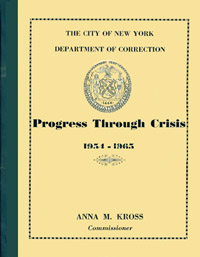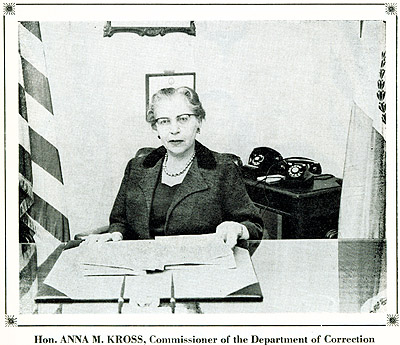
 |  |
|
disabilities through those whose difficulties derive from psychological deficiencies to those whose troubles can be traced directly to environmental factors, including lack of educational opportunity.
In order to obtain the most expert help and advice in the classification and curative treatment of our prison population, we have during this Administration officially brought into our correctional program the New York City Department of Health, which now has full responsibility for medical diagnosis and care of our prisoners, and the New York City Community Mental Health Board, which supplies our Chief Psychiatrist, who gives direction to our staff of fifteen psychiatrists and six psychologists (compared with one full-time psychiatrist, and another who spent one morning a week at the House of Detention for Women, and only two psychologists employed by the Department of Correction at the beginning of 1954). Training in lay counseling is given to successive groups of Correction Officers.
To an all-too-small extent, but setting the pattern for future all-inclusive treatment, our social workers and other professionals who conduct certain research projects give to selected groups of offenders pre-release guidance and supportive aftercare, including special employment aid. Chaplains in growing numbers have received training in pastoral counseling on Rikers Island, giving them new insight into the role that religion can play in building a bridge back to the law-abiding community for those who have strayed.
Religious correctional services have advanced from former simple weekly and holiday ministrations to a more ambitious program of pastoral counseling and individual helpfulness, training for which has been participated in since 1957 by Union Theological Seminary and the Council for Clinical Training, and since 1963 by Hebrew Union College Jewish Institute of Religion. Interfaith activities have for several years also included a program of morally oriented discussions in conjunction with specially chosen motion pictures.
Education, the most potent tool in the rehabilitation of offenders, has been a main concern of this Administration.
The most ambitious of our educational projects is conducted by the New York City Board of Education, with whose help we have blazed a pioneer trail through the opening on Rikers Island in the fall of 1959 of P. S. 616, the first such public school ever operated within the confines of a municipal short-term prison system. A new action-research approach to the problem of restoring prisoners to productive and law-abiding roles in society was launched October 18, 1965 at the New York City Correctional Institution for Men, Adolescent Division, Rikers Island.
This multi-pronged program will involve 1000 male sentenced adolescents (16-21) in reception testing, vocational training, remedial education and counseling at Rikers Island while serving time and in follow-up job placement, counseling and evaluation in the community upon release. The selected youth will receive training in skills required for entrance-level job placement in carefully chosen trades having a labor market potential.
The program will also involve 1,000 male adolescent inmates representing the control study group.
This group will not receive the specialized training accorded to the selected adolescents but will participate in the standard institutional program. The research and appraisal phase of the program known as SERVE is conducted by the Social Restoration Research Center, a division of the Staten Island Mental Health Society. Inc., and has been funded by a grant from the United States Office of Educa- [In printed book, the text continues on Page 20.]
<<=== Previous
|